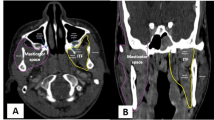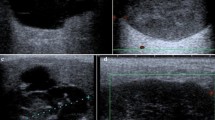Abstract
The aim of this study was to determine the factors influencing the use of a transcranial (TC) approach in pituitary adenomas and suggest a decision-making tree for the surgical strategy. The data for 23 (4.6 %) patients who underwent TC surgery from amongst 494 pituitary adenomas were retrospectively analyzed. Eight factors on magnetic resonance imaging (MRI) that could predict a difficult transsphenoidal (TS) surgery were noted. Adverse findings at TS surgery leading to a 2nd stage TC surgery were documented. Eighteen of the 23 cases were giant adenomas. Thirteen patients underwent TC surgery alone or as an initial approach when combined with TS while 10 underwent 2nd stage TC surgery following a TS approach. Most cases in the first group had 3 or more radiological factors in combination with a small sella. The 2nd group had higher sellar tumor volumes and fewer unfavourable radiological factors that led to the initial use of the TS approach. A hard, fibrous consistency or a significant residue obscured from the surgeon’s view, and difficulty in hemostasis were additional factors prompting the use of a TC approach. Tumor excision ≥90 % could be achieved in 13 cases (56.5 %). Post-operative RT was administered in 12 patients. There were 2 deaths (8.7 %) and the major morbidity rate was 43 %. Despite advances in endoscopic surgery the TC approach may be required in 5 % of cases. A study of the preoperative MRI for factors that predict difficulty with the TS approach might encourage the surgeon to consider a TC surgery either as an initial approach or combined with a TS surgery.








Similar content being viewed by others
Abbreviations
- TC:
-
Transcranial
- TS:
-
Transsphenoidal
- MRI:
-
Magnetic resonance imaging
- T4:
-
Thyroxine
- FTC:
-
Free thyroxine concentration
- TSH:
-
Thyroid stimulating hormone
- FSH:
-
Follicle stimulating hormone
- LH:
-
Luteinizing hormone
- GH:
-
Growth hormone
- IGF-1:
-
Insulin-like growth factor
- OGTT:
-
Oral glucose tolerance test
- PACS:
-
Picture archiving and communication system
- ICA:
-
Internal carotid artery
- FLAIR:
-
Fluid attenuated inversion recovery
- CT:
-
Computed tomography
- ACoA:
-
Anterior communicating artery
- ETCO2 :
-
End tidal CO2
- CSF:
-
Cerebrospinal fluid
- RT:
-
Radiation therapy
- SRT:
-
Stereotactic radiation therapy
- SD:
-
Standard deviation
References
Wilson CB (1984) A decade of pituitary microsurgery. The Herbert Olivecrona lecture. J Neurosurg 61:814–833
Laws ER, Jane JA Jr (2001) Pituitary tumors–long-term outcomes and expectations. Clin Neurosurg 48:306–319
Chacko AG, Chandy MJ (2002) Transsphenoidal line of vision on MRI for pituitary tumor surgery. Neurol India 50:136–140
Zada G, Du R, Laws ER Jr (2011) Defining the “edge of the envelope”: patient selection in treating complex sellar-based neoplasms via transsphenoidal versus open craniotomy. J Neurosurg 114:286–300
Komotar RJ, Starke RM, Raper DMS, Anand VK, Schwartz TH (2012) Endoscopic endonasal compared with microscopic transsphenoidal and open transcranial resection of giant pituitary adenomas. Pituitary 15:150–159
Di Maio S, Cavallo LM, Esposito F, Stagno V, Corriero OV, Cappabianca P (2011) Extended endoscopic endonasal approach for selected pituitary adenomas: early experience. J Neurosurg 114:345–353
Youssef AS, Agazzi S, van Loveren HR (2005) Transcranial surgery for pituitary adenomas. Neurosurgery 57:168–175 (discussion 168–175)
Buchfelder M, Kreutzer J (2008) Transcranial surgery for pituitary adenomas. Pituitary 11:375–384
Giustina A, Chanson P, Bronstein MD, Klibanski A, Lamberts S, Casanueva FF et al (2010) A consensus on criteria for cure of acromegaly. J Clin Endocrinol Metab 95:3141–3148
Dolenc VV (1997) Transcranial epidural approach to pituitary tumors extending beyond the sella. Neurosurgery 41:542–550 (discussion 551–552)
Nath G, Korula G, Chandy MJ (1995) Effect of intrathecal saline injection and Valsalva maneuver on cerebral perfusion pressure during transsphenoidal surgery for pituitary macroadenoma. J Neurosurg Anesthesiol 7:1–6
Korula G, George SP, Rajshekhar V, Haran RP, Jeyaseelan L (2001) Effect of controlled hypercapnia on cerebrospinal fluid pressure and operating conditions during transsphenoidal operations for pituitary macroadenoma. J Neurosurg Anesthesiol 13:255–259
Bohinski RJ, Warnick RE, Gaskill-Shipley MF, Zuccarello M, van Loveren HR, Kormos DW et al (2001) Intraoperative magnetic resonance imaging to determine the extent of resection of pituitary macroadenomas during transsphenoidal microsurgery. Neurosurgery 49:1133–1143 (discussion 1143–1144)
Nishizawa S, Yokoyama T, Ohta S, Uemura K (1998) Surgical indications for and limitations of staged transsphenoidal surgery for large pituitary tumors. Neurol Med Chir (Tokyo) 38:213–219 (discussion 219–220)
Saito K, Kuwayama A, Yamamoto N, Sugita K (1995) The transsphenoidal removal of nonfunctioning pituitary adenomas with suprasellar extensions: the open sella method and intentionally staged operation. Neurosurgery 36:668–675 (discussion 675–676)
Mehta GU, Oldfield EH (2012) Prevention of intraoperative cerebrospinal fluid leaks by lumbar cerebrospinal fluid drainage during surgery for pituitary macroadenomas. J Neurosurg 116:1299–1303
Decker RE, Chalif DJ (1991) Progressive coma after the transsphenoidal decompression of a pituitary adenoma with marked suprasellar extension: report of two cases. Neurosurgery 28:154–157 (discussion 157–158)
Honegger J, Ernemann U, Psaras T, Will B (2007) Objective criteria for successful transsphenoidal removal of suprasellar nonfunctioning pituitary adenomas. A prospective study. Acta Neurochir (Wien) 149:21–29 (discussion 29)
Hashimoto N, Handa H, Yamagami T (1986) Transsphenoidal extracapsular approach to pituitary tumors. J Neurosurg 64:16–20
Loyo M, Kleriga E, Mateos H, de Leo R, Delgado A (1984) Combined supra-infrasellar approach for large pituitary tumors. Neurosurgery 14:485–488
Cappabianca P, Cavallo LM, de Divitiis O, Solari D, Esposito F, Colao A (2008) Endoscopic pituitary surgery. Pituitary 11:385–390
Kaptain GJ, Vincent DA, Sheehan JP, Laws ER Jr (2001) Transsphenoidal approaches for the extracapsular resection of midline suprasellar and anterior cranial base lesions. Neurosurgery 49:94–100 (discussion 100–101)
Schwartz TH, Fraser JF, Brown S, Tabaee A, Kacker A, Anand VK (2008) Endoscopic cranial base surgery: classification of operative approaches. Neurosurgery 62:991–1002 (discussion 1002–1005)
Snow RB, Lavyne MH, Lee BC, Morgello S, Patterson RH Jr (1986) Craniotomy versus transsphenoidal excision of large pituitary tumors: the usefulness of magnetic resonance imaging in guiding the operative approach. Neurosurgery 19:59–64
Bahuleyan B, Raghuram L, Rajshekhar V, Chacko AG (2006) To assess the ability of MRI to predict consistency of pituitary macroadenomas. Br J Neurosurg 20:324–326
Ahmad FU, Pandey P, Mahapatra AK (2005) Post operative “pituitary apoplexy” in giant pituitary adenomas: a series of cases. Neurol India 53:326–328
Goel A, Deogaonkar M, Desai K (1995) Fatal postoperative “pituitary apoplexy”: its cause and management. Br J Neurosurg 9:37–40
Alleyne CH Jr, Barrow DL, Oyesiku NM (2002) Combined transsphenoidal and pterional craniotomy approach to giant pituitary tumors. Surg Neurol 57:380–390 (discussion 390)
Symon L, Jakubowski J, Kendall B (1979) Surgical treatment of giant pituitary adenomas. J Neurol Neurosurg Psychiatr 42:973–982
King WA, Rodts GE, Becker DP, Mc Bride DQ (1996) Microsurgical management of giant pituitary tumors. Skull Base Surg 6:17–26
Mortini P, Barzaghi R, Losa M, Boari N, Giovanelli M (2007) Surgical treatment of giant pituitary adenomas: strategies and results in a series of 95 consecutive patients. Neurosurgery 60:993–1002 (discussion 1003–1004)
D’Ambrosio AL, Syed ON, Grobelny BT, Freda PU, Wardlaw S, Bruce JN (2009) Simultaneous above and below approach to giant pituitary adenomas: surgical strategies and long-term follow-up. Pituitary 12:217–225
Sinha S, Sharma B (2010) Giant pituitary adenomas—an enigma revisited. Microsurgical treatment strategies and outcome in a series of 250 patients. Br J Neurosurg 24:31–39
Bakay L (1950) The results of 300 pituitary adenoma operations (Prof. Herbert Olivecrona’s series). J Neurosurg 7:240–255
Horrax G, Hare HF, Poppen JL, Hurxthal LM, Younghusband OZ (1952) Chromophobe pituitary tumors. II. Treatment. J Clin Endocrinol Metab 12:631–641
Tonnis W, Oberdisse K, Weber E (1953) Report on 264 operated cases of hypophyseal adenoma. Acta Neurochir (Wien) 3:113–130
Baker GS (1960) Treatment of pituitary adenomas. Arch Surg 81:842–846
Elkington SG, McKissock W (1967) Pituitary adenoma: results of combined surgical and radiotherapeutic treatment of 260 patients. Br Med J 1:263–266
Ray BS, Patterson RH Jr (1971) Surgical experience with chromophobe adenomas of the pituitary gland. J Neurosurg 34:726–729
Kunc Z (1973) Surgical problems in hypophyseal chromophobe adenomas. Cesk Neurol 36:349–356
Wirth FP, Schwartz HG, Schwetschenau PR (1974) Pituitary adenomas: factors in treatment. Clin Neurosurg 21:8–25
Kunicki A, Madraszkiewicz E, Szwagrzyk E (1975) Surgical management and therapeutic results in 114 cases of pituitary adenoma. Neurol Neurochir Pol 9:503–509
Symon L, Jakubowski J (1979) Transcranial management of pituitary tumors with suprasellar extension. J Neurol Neurosurg Psychiatr 42:123–133
Valtonen S, Myllymäki K (1986) Outcome of patients after transcranial operation for pituitary adenoma. Ann Clin Res 18:43–45
Guidetti B, Fraioli B, Cantore GP (1987) Results of surgical management of 319 pituitary adenomas. Acta Neurochir (Wien) 85:117–124
Suzukawa K (1989) Evaluation of the transcranial approach to pituitary adenomas based on quantitative analysis of pre- and postoperative visual function. Neurol Med Chir (Tokyo) 29:1012–1019
van Lindert EJ, Grotenhuis JA, Meijer E (1991) Results of follow-up after removal of non-functioning pituitary adenomas by transcranial surgery. Br J Neurosurg 5:129–133
Mohr G, Hardy J, Comtois R, Beauregard H (1990) Surgical management of giant pituitary adenomas. Can J Neurol Sci 17:62–66
Garibi J, Pomposo I, Villar G, Gaztambide S (2002) Giant pituitary adenomas: clinical characteristics and surgical results. Br J Neurosurg 16:133–139
Chacko G, Chacko AG, Lombardero M, Mani S, Seshadri MS, Kovacs K et al (2009) Clinicopathologic correlates of giant pituitary adenomas. J Clin Neurosci 16:660–665
Zhang X, Fei Z, Zhang J, Fu L, Zhang Z, Liu W et al (1999) Management of nonfunctioning pituitary adenomas with suprasellar extensions by transsphenoidal microsurgery. Surg Neurol 52:380–385
Chacko AG, Chacko G, Seshadri MS, Chandy MJ (2003) The “capsule” of pituitary macroadenomas represents normal pituitary gland: a histopathological study. Br J Neurosurg 17:213–218
Goel A, Nadkarni T, Muzumdar D, Desai K, Phalke U, Sharma P (2004) Giant pituitary tumors: a study based on surgical treatment of 118 cases. Surg Neurol 61:436–445 (discussion 445–446)
Fisher BJ, Gaspar LE, Noone B (1993) Giant pituitary adenomas: role of radiotherapy. Int J Radiat Oncol Biol Phys 25:677–681
Petrossians P, Borges-Martins L, Espinoza C, Daly A, Betea D, Valdes-Socin H et al (2005) Gross total resection or debulking of pituitary adenomas improves hormonal control of acromegaly by somatostatin analogs. Eur J Endocrinol 152:61–66
Colao A, Attanasio R, Pivonello R, Cappabianca P, Cavallo LM, Lasio G et al (2006) Partial surgical removal of growth hormone-secreting pituitary tumors enhances the response to somatostatin analogs in acromegaly. J Clin Endocrinol Metab 91:85–92
Acknowledgments
We would like to thank Dr. KS Jacob for helping with the statistical analysis. We would also like to thank Mr. Rajkumar G. and Dr. K Srinivasa Babu for the illustrations.
Ethical standards
The authors declare that there were no ethical issues related to this study and have complied with the current laws of our country.
Conflict of interest
The authors declare that they have no conflict of interest.
Author information
Authors and Affiliations
Corresponding author
Rights and permissions
About this article
Cite this article
Pratheesh, R., Rajaratnam, S., Prabhu, K. et al. The current role of transcranial surgery in the management of pituitary adenomas. Pituitary 16, 419–434 (2013). https://doi.org/10.1007/s11102-012-0439-z
Published:
Issue Date:
DOI: https://doi.org/10.1007/s11102-012-0439-z




